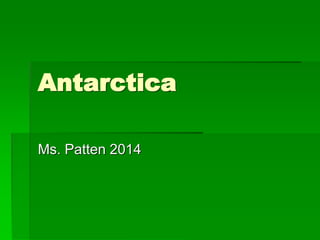
Antarctica
- 2. What is Antarctica like? The prefix ant- means opposite or opposing Most southerly continent Fifth largest continent Driest, highest, coldest and windiest continent Antarctica holds 90 percent of all the world's ice and 70 percent of all the world's fresh water.
- 3. What is Antarctica like? Antarctica is a large land mass buried under a vast ice cap (98%) very different from the Arctic which is a frozen ocean surrounded by land the North Pole is located on shifting sea-ice In the winter, the temperature at the South Pole averages about -60 degrees C (-76 degrees F). The farther from the coast one goes the higher and colder it becomes.
- 4. What is Antarctica like? The average thickness of the ice sheet is 7,200 feet If the ice cap were to melt, the average sea level would rise 230 feet, easily inundating most coastal cities: New York, London, and Hong Kong The weight of the ice is so enormous that the continent buried beneath it would rise to an average altitude of 3,280 feet if the ice sheet were removed
- 5. Animal life? Penguins, whales, seals, krill (Norwegian word for whale food) and fish but no land mammals and no native peoples Polar bears, Eskimos and Santa are found in the Arctic, not the Antarctic
- 6. Do people live on Antarctica? There are no permanent residents of Antarctica Roughly 4,000 scientists and personnel during the summer season; 1000 in the winter The population at the South Pole peaks when the summer sun is high, reaching 125. The number of people at the South Pole during the winter of 1993 was only 28.
- 7. Who owns Antarctica? No one country actually owns Antarctica although several states have claimed territory Antarctic Treaty signed by 12 countries in 1959 dictates the use of the continent
- 8. Australia The Australian Antarctic Division maintains four permanent research stations; Mawson, Davis and Casey on the Antarctic mainland, and Macquarie Island in the subantarctic. All four stations are occupied year-round by scientists and support staff.
- 9. Sources http://faculty.umf.maine.edu/~legler/antar cticawebsite/coolf.htm http://geography.about.com/cs/politicalge og/a/antarctica.htm?terms=antarctic http://www.aad.gov.au/default.asp?casid =6238 http://astro.uchicago.edu/cara/outreach/c oldfacts.html